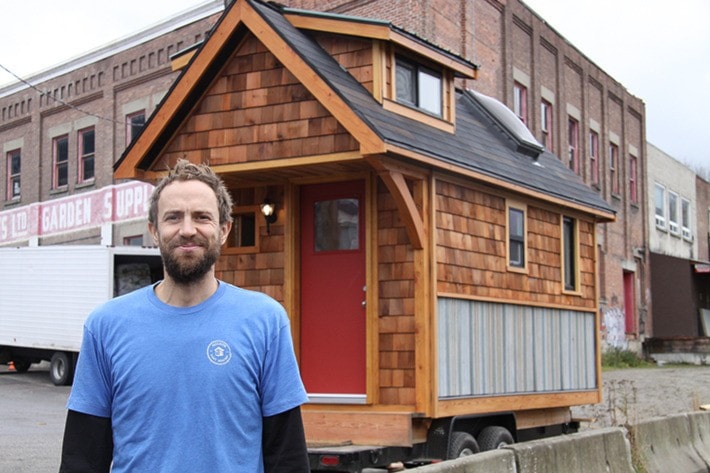If you've ever wanted to sell all your possessions and live the simple life, Nelson Tiny Houses builds homes to support that kind of change — if you can find a place to put one.
The City of Nelson is considering a change to its zoning bylaws to allow alleyway homes on most residential properties, but the locally built tiny homes are too small to legally occupy within city limits.
The bylaw stipulates that residential dwellings must be at least 15 feet wide, but the width of an average tiny home is under 10 feet.
Nelson development manager Dave Wahn said the minimum was put in place long before his time with the city. He suspects it's intended to prevent single-wide mobile homes from being placed on properties.
Under legislation, the zoning bylaw can't specify the styles of home it allows.
"You can't say, 'yes we're going to allow tiny homes but not mobile homes'," Wahn said, adding that if somebody wanted to put a tiny home on their property they could apply for a variance permit and make their case to city council.
Or you could move into the Regional District where similar restrictions don't exist.
Wahn said he's aware of several tiny homes around the city that are built onto trailers, but nobody has yet come to the city requesting an occupancy permit for one.
At least one of the tiny homes in town was built by Nelson Tiny Houses founder Seth Reidy.
A home builder for 18 years, Reidy built several tiny homes in place for clients before last year deciding to try to make a business out of it. He built his prototype on a trailer and when he parked it outside Ellison's for an open house last spring, someone immediately offered to buy it.
"They're perfect, if you have some extra property, to put in as rental units," Reidy said. "It would pay for itself in no time."
If that first house hadn't sold, he'd planned to use it as an inlaw suite on his own property at Mountain Station. But selling his first unit inspired him to build a second prototype, which he showed off at another open house this past weekend.
 The first design he called the "versatile house" or "v-house" and was a single 108-square-foot room with a sleeping loft that would make a good writing studio, if you didn't want to live in it. The second style is 135-square-feet, called the "Acorn House" and is much more purpose built as a home, with a shower, kitchen and dining area, and larger sleeping quarters.
The first design he called the "versatile house" or "v-house" and was a single 108-square-foot room with a sleeping loft that would make a good writing studio, if you didn't want to live in it. The second style is 135-square-feet, called the "Acorn House" and is much more purpose built as a home, with a shower, kitchen and dining area, and larger sleeping quarters.
Reidy builds the homes from reclaimed materials and sells them for between $25,000 and $40,000, depending on the style. They take him one to three months to build, depending on the availability of materials.
"You can pretty much use the cut offs from a big project to build a tiny house, but it takes some time to source the materials," Reidy said, noting that all the cabinets and furniture need to be custom built for the space.
"You're forced to be really thoughtful and pay attention to what you're doing," he said. "The bigger a house gets the less thought needs to go into it — both on the builder's end, and for the people living in it. When you have a small space, you need to think about being efficient and making the best use of every corner and nook."
Reidy said he's talked to lots of people interested in tiny houses and there was a steady stream of visitors at both open houses, but the city's restriction on smaller homes is a barrier. He's considering designing a larger version to comply with city requirements.
"It would mostly be empty square footage, so it wouldn't add much to the building cost," he said.
Nelson's John Paolozzi, a tiny home aficionado who provides feedback on land use matters as a member of the city's Advisory Planning Commission, personally believes there should be opportunities for people to try to build smaller than what's currently permitted in zoning bylaws. But he's not sure going any smaller than 200 square feet (about a 14' by 14' footprint) is practical within the city.
"You need to have a certain amount of storage within the house — for seasonal things like winter coats and gear — and there needs to be proper plumbing. It's hard to do that in 100 square feet," said Paolozzi.
He would know. A few years back he built a 180 square foot cottage on an island off the coast of Vancouver to use as a vacation home with his wife and two sons. The family never actually lived in the cottage, but building it gave him a good sense of what's possible.
He's been watching with interest as cities like Vancouver and San Francisco change their building requirements to make way for smaller and smaller homes. He hopes Nelson eventually will follow suit.
"We need to look at these solutions big cities are using to create more housing stock," he said, noting he plans to raise the discussion of smaller housing with the planning commission in the coming months. "We've been opening up opportunities for lower cost housing options — making it easier to build a secondary suites or laneway housing — and I think it's time we start talking about building smaller as part of that."
